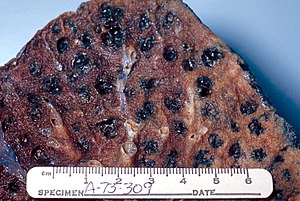用户:Yexiaoxing/workspace/COPD
| 慢性阻塞性肺病 Chronic Obstructive Pulmonary Disease | |
|---|---|
 | |
| Gross pathology of a lung showing centrilobular-type emphysema characteristic of smoking. This close-up of the fixed, cut lung surface shows multiple cavities lined by heavy black carbon deposits. | |
| 分类和外部资源 | |
| ICD-10 | J40–J44, J47 |
| ICD-9-CM | 490–492, 494–496 |
| OMIM | 606963 |
| DiseasesDB | 2672 |
| MedlinePlus | 000091 |
| eMedicine | med/373 emerg/99 |
| MeSH | C08.381.495.389 |
慢性阻塞性肺病(Chronic Obstructive Pulmonary Disease, COPD), 亦可称为慢性阻塞性肺炎 (COLD)和慢性阻塞性呼吸道疾病(COAD)。与其它疾病相比,COPD是阻塞性肺炎的一种,主要表现为持续性的气流受限。 并会随着时间推移病情加重。 COPD的主要症状包括呼吸短促,咳嗽,及喀痰。[1]多数有慢性支气管炎的病人同时也是该病患者。[2]
吸烟是导致慢性阻塞性肺病的主要原因。其他相对次要的因素,像空气污染和遗传也能从一定程度诱发慢性阻塞性肺病。[3] 在发展中国家,导致空气污染最常见的原因是恶劣的厨房通风环境及用于采暖的炉火。长期暴露在这些诱发性的因素中,会使肺部产生炎症反应,并导致气流通道变窄及肺组织功能障碍,即肺气肿。[4] 这一诊断基于肺功能测试所给出的空气流通差的标准.[5] 与哮喘的不同之处在于, 即使在药物治疗的帮助下,肺气肿气流减少的病症也不会有明显改善。
尽量减少暴露于诱发性的环境可有效预防慢性阻塞性肺病。这包括尽可能地减少吸烟频率和改善室内外的空气质量。慢性阻塞性肺病的治疗方式包括 戒烟、接种疫苗、肺康复治疗,以及常用的各种吸入性支气管扩张药和皮质类固醇。有些患者还需要长期供氧或肺移植。[4] 在遇到急性发作的患者时,可采取加大药物用量以及住院治疗的方式。
全世界慢性阻塞性肺病的患者,有大约3亿2900万。换句话说全世界有百分之五的人患有此病。2012年的统计显示,慢性阻塞性肺病是导致人类死亡的第三大病症,死亡人数超过300万。[6]这样的高死亡率是由于吸烟人数的陡增以及某些国家的人口老龄问题。[7]2010年,慢性阻塞性肺病导致了2.1万亿美元的经济损失。 [8]
病情征兆和症状
[编辑]
慢性阻塞性肺病最常见的症状是多痰、呼吸短促和持续地咳嗽,[9]前面提到的这三种症状还会持续很长一段时间。[2]并会随着时间流逝病情加重。[4]目前还不清楚是否存在不同类型的慢性阻塞性肺病。[3]根据以往的记录,慢性阻塞性肺病分为肺气肿和慢性支气管炎两种,然而,肺气肿更多的是对肺部功能变化的阐述而不是一种疾病; 慢性支气管炎仅仅只是一个症状的参照体,它可能诱发于慢性阻塞性肺病。[1]
咳嗽
[编辑]慢性阻塞性肺病通常的第一个症状就是持续性的咳嗽。当这种症状持续两年,并且每年持续咳嗽的频率超过3个月,并伴有多痰,又找不到其它解释,那么这就是理论上的慢性支气管炎。 在慢性阻塞性肺病完全暴露出来以前,上述的症状极有可能发生。 咳嗽的带痰量在一天之中也会有所变化。 有些患者甚至不咳嗽,或只是偶尔咳嗽,并且咳嗽的频率也不高。 有些慢性阻塞性肺病的患者的咳嗽还会被误认为"吸烟者的咳嗽". 由于社会和不同文化的影响,患者会吞痰或吐痰。 剧烈的咳嗽还有可能导致肋骨骨折或暂时失去知觉。 通常慢性阻塞性肺病的咳嗽都有一个长期患普通感冒的病史。 [9]
呼吸短促
[编辑]呼吸短促是最困扰慢性阻塞性肺病患者的症状[10]。患者通常这样描述它:“我的呼吸太费劲儿了”、“我喘不过气了”又或者“我不能呼吸到足够的氧气”。[11]不同的文化有不同的说法。[9]呼吸短促加剧的情况主要发生在需要长时间用力时,并随时间病情加重。[9]在慢性阻塞性肺病的后期,呼吸短促在休息时也会出现。[12][13]出现这种情况的慢性阻塞性肺病的患者,通常都有焦虑的性格和低质量的生活水准。[9]许多慢性阻塞性肺病的后期患者都通过噘唇呼吸,然而这会加剧某些患者的呼吸急促症状。[14][15]
其它病征
[编辑]对慢性阻塞性肺病患者而言,有可能呼气需要的时间比吸气要长。[16]在这种情况下会产生胸闷。[9]但这并不多见,而且其他病也可导致胸闷。[10]那些有阻塞性气流问题的患者可能会伴有喘鸣 或者在用听诊器检查患者胸部时,会听到患者吸气减少的声音。[16] 虽然{{link-en|桶状胸|Barrel chest))是慢性阻塞性肺病的一个征兆,但这种情况也并不常见。[16]随着病情加重,某些患者呼吸不得不采用三脚架姿势[2]
慢性阻塞性肺病的后期会导致肺部高压,这将引起心脏右心室。[4][17][18] 这即是肺心病,会导致[[外周性水肿 |腿肿]][9]和颈部血管突出。[4] 与其他肺部的疾病比,慢性阻塞性肺病是诱发肺心病的主因。[17] 自从大量使用氧气疗法后,肺心病发病率有显著减少。[2]
由于其他诱因存在,慢性阻塞性肺病通常都不会单独发作。[3] 这些带危险性的诱因包括: 缺血性心脏病、高血压、糖尿病、肌肉萎缩、骨质疏松症、肺癌、焦虑症 以及 抑郁症.[3] 那些重度患者还会常常觉得 累。[9] 手指甲杵状 不是慢性阻塞性肺病特有的症状,相反,更应考虑是潜伏的肺癌的征兆。[19]
病情发作
[编辑]急性慢性阻塞性肺病从理论上定义为,已患有慢性阻塞性肺病的患者出现的加剧的呼吸短促、咳痰量剧增、痰的颜色改变(从无色变至绿色或黄色)或是加剧的咳嗽等等附加症状。[16] 急性慢性阻塞性肺病也可同时与加强的呼吸征兆同时出现。比如呼吸急促、心跳加剧、流汗、呼吸肌肉明显运动,发绀以及神经错乱或者在病情严重时的一系列的呼吸挣扎行为。[16][20]在用听诊器检查患者时,还有可能听到肺部的撕裂声。[21]
发病原因
[编辑]引发慢性阻塞性肺病的主要原因是吸烟,在某些国家,这一主要原因表现为长期暴露于室内炉火的污染源。[1] 由后者诱发的慢性阻塞性肺病还会潜伏很多年。[1] 基因也会增加患慢性阻塞性肺病的基率。[1]
吸烟
[编辑]从全球的范围来看,导致慢性阻塞性肺病的首要罪魁是抽烟。[1] 约占吸烟总人数百分之20的烟民有很大基率患慢性阻塞性肺病,[23] 而其中那些终身烟民,有一半的人都将患慢性阻塞性肺病。[24]在美国和英国,百分之80至95的慢性阻塞性肺病患者都是烟民。他们或正在吸烟,或曾吸烟。[23][25][26] 而长期暴露于烟环境则会增加患慢性阻塞性肺病的可能性。[27] 需要说明的是, 面对吸烟的危害性,妇女比男性更脆弱。[26] 在非吸烟者患慢性阻塞性肺病患者中, 被动吸烟 诱发的慢性阻塞性肺病就占了百分之20。[25]其他类型的抽烟,像大麻,雪茄及水管烟,也是诱因之一。[1] 在怀孕期间抽烟的妇女还有可能增加婴儿患慢性阻塞性肺病的风险。[1]
参考文献
[编辑]- ^ 1.0 1.1 1.2 1.3 1.4 1.5 1.6 1.7 Vestbo, Jørgen. Definition and Overview (PDF). Global Strategy for the Diagnosis, Management, and Prevention of Chronic Obstructive Pulmonary Disease. Global Initiative for Chronic Obstructive Lung Disease. 2013: 1–7.
- ^ 2.0 2.1 2.2 2.3 Reilly, John J.; Silverman, Edwin K.; Shapiro, Steven D. Chronic Obstructive Pulmonary Disease. Longo, Dan; Fauci, Anthony; Kasper, Dennis; Hauser, Stephen; Jameson, J.; Loscalzo, Joseph (编). Harrison's Principles of Internal Medicine 18th. McGraw Hill. 2011: 2151–9. ISBN 978-0-07-174889-6.
- ^ 3.0 3.1 3.2 3.3 Decramer M, Janssens W, Miravitlles M. Chronic obstructive pulmonary disease. Lancet. April 2012, 379 (9823): 1341–51. PMID 22314182. doi:10.1016/S0140-6736(11)60968-9.
- ^ 4.0 4.1 4.2 4.3 4.4 Rabe KF, Hurd S, Anzueto A, Barnes PJ, Buist SA, Calverley P, Fukuchi Y, Jenkins C, Rodriguez-Roisin R, van Weel C, Zielinski J. Global strategy for the diagnosis, management, and prevention of chronic obstructive pulmonary disease: GOLD executive summary. Am. J. Respir. Crit. Care Med. September 2007, 176 (6): 532–55. PMID 17507545. doi:10.1164/rccm.200703-456SO.
- ^ Nathell L, Nathell M, Malmberg P, Larsson K. COPD diagnosis related to different guidelines and spirometry techniques. Respir. Res. 2007, 8 (1): 89. PMC 2217523
 . PMID 18053200. doi:10.1186/1465-9921-8-89.
. PMID 18053200. doi:10.1186/1465-9921-8-89.
- ^ The 10 leading causes of death in the world, 2000 and 2011. World Health Organization. July 2013 [November 29, 2013].
- ^ Mathers CD, Loncar D. Projections of Global Mortality and Burden of Disease from 2002 to 2030. PLoS Med. November 2006, 3 (11): e442. PMC 1664601
 . PMID 17132052. doi:10.1371/journal.pmed.0030442.
. PMID 17132052. doi:10.1371/journal.pmed.0030442.
- ^ Lomborg, Bjørn. Global problems, local solutions : costs and benefits. Cambridge University Pres. 2013: 143. ISBN 978-1-107-03959-9.
- ^ 9.0 9.1 9.2 9.3 9.4 9.5 9.6 9.7 Vestbo, Jørgen. Diagnosis and Assessment (PDF). Global Strategy for the Diagnosis, Management, and Prevention of Chronic Obstructive Pulmonary Disease. Global Initiative for Chronic Obstructive Lung Disease. 2013: 9–17.
- ^ 10.0 10.1 National Institute for Health and Clinical Excellence. Clinical guideline 101: Chronic Obstructive Pulmonary Disease. London, June 2010.
- ^ Mahler DA. Mechanisms and measurement of dyspnea in chronic obstructive pulmonary disease. Proceedings of the American Thoracic Society. 2006, 3 (3): 234–8. PMID 16636091. doi:10.1513/pats.200509-103SF.
- ^ What Are the Signs and Symptoms of COPD?. National Heart, Lung, and Blood Institute. July 31, 2013 [November 29, 2013].
- ^ MedlinePlus百科全书 Chronic obstructive pulmonary disease
- ^ Morrison, [edited by] Nathan E. Goldstein, R. Sean. Evidence-based practice of palliative medicine. Philadelphia: Elsevier/Saunders. 2013: 124. ISBN 978-1-4377-3796-7.
- ^ Holland AE, Hill CJ, Jones AY, McDonald CF. Holland, Anne E , 编. Breathing exercises for chronic obstructive pulmonary disease. Cochrane Database Syst Rev. 2012, 10: CD008250. PMID 23076942. doi:10.1002/14651858.CD008250.pub2.
- ^ 16.0 16.1 16.2 16.3 16.4 Gruber, Phillip. The Acute Presentation of Chronic Obstructive Pulmonary Disease In the Emergency Department: A Challenging Oxymoron. Emergency Medicine Practice. November 2008, 10 (11).
- ^ 17.0 17.1 Weitzenblum E, Chaouat A. Cor pulmonale. Chron Respir Dis. 2009, 6 (3): 177–85. PMID 19643833. doi:10.1177/1479972309104664.
- ^ Cor pulmonale. Professional guide to diseases 9th. Philadelphia: Wolters Kluwer Health/Lippincott Williams & Wilkins. 2009: 120–2. ISBN 978-0-7817-7899-2.
- ^ Mandell, editors, James K. Stoller, Franklin A. Michota, Jr., Brian F. The Cleveland Clinic Foundation intensive review of internal medicine 5th. Philadelphia: Wolters Kluwer Health/Lippincott Williams & Wilkins. 2009: 419. ISBN 978-0-7817-9079-6.
- ^ Brulotte CA, Lang ES. Acute exacerbations of chronic obstructive pulmonary disease in the emergency department. Emerg. Med. Clin. North Am. May 2012, 30 (2): 223–47, vii. PMID 22487106. doi:10.1016/j.emc.2011.10.005.
- ^ Spiro, Stephen. Clinical respiratory medicine expert consult 4th. Philadelphia, PA: Saunders. 2012: Chapter 43. ISBN 978-1-4557-2329-4.
- ^ World Health Organization. WHO Report on the Global Tobacco Epidemic 2008: The MPOWER Package (PDF). Geneva: World Health Organization. 2008: 268–309. ISBN 92-4-159628-7.
- ^ 23.0 23.1 Ward, Helen. Oxford Handbook of Epidemiology for Clinicians. Oxford University Press. 2012: 289–290. ISBN 978-0-19-165478-7.
- ^ Laniado-Laborín, R. Smoking and chronic obstructive pulmonary disease (COPD). Parallel epidemics of the 21st century. International journal of environmental research and public health. January 2009, 6 (1): 209–24. PMC 2672326
 . PMID 19440278. doi:10.3390/ijerph6010209.
. PMID 19440278. doi:10.3390/ijerph6010209.
- ^ 25.0 25.1 Rennard, Stephen. Clinical management of chronic obstructive pulmonary disease 2nd. New York: Informa Healthcare. 2013: 23. ISBN 978-0-8493-7588-0.
- ^ 26.0 26.1 Anita Sharma ; with a contribution by David Pitchforth ; forewords by Gail Richards; Barclay, Joyce. COPD in primary care. Oxford: Radcliffe Pub. 2010: 9. ISBN 978-1-84619-316-3.
- ^ Goldman, Lee. Goldman's Cecil medicine 24th. Philadelphia: Elsevier/Saunders. 2012: 537. ISBN 978-1-4377-1604-7.
外部链接
[编辑]- 开放目录项目中的“Yexiaoxing/workspace/COPD”
- COPD-BOLD International Research Platform
- National Heart, Lung and Blood Institute - COPD U.S. NHLBI Information for Patients and the Public page.
- Global Initiative for Chronic Obstructive Lung Disease (GOLD)
- Economic Impact of COPD and Cost Effective Solutions. Access Economics. The Australian Lung Foundation. 2008. 已忽略未知参数
|month=(建议使用|date=) (帮助) - About COPD Medical information about COPD for patients and their families.
- 慢阻肺病关注组(香港)
- 慢阻肺病关注组脸书专页
- Global Initiative for Chronic Obstructive Lung Disease (GOLD) clinical practive guidelines (2013)



